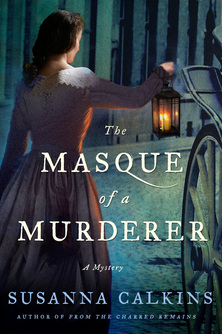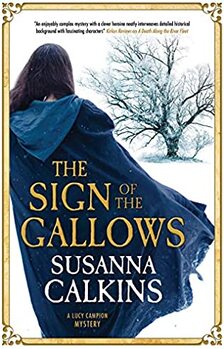I went on to write two other mysteries, Murder Knocks Twice and The Fate of a Flapper set in 1929 Chicago, featuring Gina Ricci, a cocktail waitress in a Chicago speakeasy. (And some readers have asked me if Gina is Lucy's great-great-great-great-great granddaughter, and I always say, 'sure why not?' When the series is complete maybe I'll work out Gina's genealogy). I honestly thought that my time with Lucy and 17th century London would be over after DARF was published. But then Severn House approached me about writing another Lucy, and continuing the series, and I jumped at this amazing opportunity.
Getting back into Lucy's world was not nearly as difficult as I imagined. Essentially I just had to push my cocktail glasses off the table, stack my Prohibition books back on the shelf, and change my music from flappers fun to classical (I can't quite bring myself to listen to madrigals and baroque music, or drink mead for that matter, to get myself in the right mood). Each of my first four Lucy books all came to me in the form of an image, and The Sign of the Gallows was no exception. I immediately had the image of Lucy standing at a crossroads, because that's where I mentally pictured her (and me) to be. It can't get more "on the head" than that. This image was particularly appealing location for a mystery because in the 17th century a crossroads was still very much viewed as a dangerous and frightening place. Murderers and suicides were often buried at crossroads since they could not be buried in sacred grounds. The idea was that their tortured spirits would not be able to find their way back home and they'd get confused at a crossroads. That also meant, of course, that travelers needed to be wary, when passing through a crossroads, lest they attract one of these unfortunate souls and carry them back home with them.... That image gave way to a plot...Lucy discovers a dead man hanging from a gallows at the crossroads, drawing her into a puzzling mystery. The image of Lucy at the crossroads also informed Lucy's lot in life, and I wrote much of the novel with the idea that Lucy would be on a definite path by the story's close. However, ironically, just as I was writing the last chapter, I was asked by Severn House to write a sixth Lucy Campion mystery-- which meant I had to rethink Lucy's crossroads conundrum. A fun challenge to have! It's been so fun to jump back into Lucy's world. As I was writing, I did have this weird sense my characters had been waiting for me. A little like Pirandello's "Six Characters in Search of an Author," only the 17th century version. (Although that's a little disturbing, if you think about it too much). It's been really gratifying to be able to move Lucy's story forward, and to tell a story I never thought would be told.
8 Comments
 I'm so happy and honored to say that my third historical novel, The Masque of a Murderer, officially launches today, April 14! And while I may not be quite as giddy when my first novel, A Murder at Rosamund's Gate (2013) launched two years ago--because nothing can ever compare to the release of a first novel--I'm still as loopy as I was last year, when From the Charred Remains (2014) entered the world. Recently, in preparation for the launch, I've been answering a lot of fun and interesting questions about The Masque of a Murderer (the historical background, the story and characters, and my writing process etc). So, I thought I'd do a quick round-up here! I welcome you to:
Thanks so much for sharing this journey with me!!! And I appreciate all the bloggers and reviewers who hosted me, including those through Amy Bruno's Historical Fiction Virtual Blog Tours! And I'm always so grateful to the wonderful people at Minotaur, especially Kelley Ragland and Elizabeth Lacks, and my agent David Hale Smith, and of course my wonderful alpha reader, Matt Kelley!! (and now, I turn my attention back to A DEATH ALONG THE RIVER FLEET, due out April 2016!!!!)  Anyone who knows me, knows I really love doing puzzles. Even when I was a kid, I was always doing puzzles--from word searches to crossword puzzles to substitution ciphers (probably because I felt like I was really decoding mysteries). But when I was in graduate school, I first encountered the fun of acrostics. In the high Middle Ages, scholars like Alcuin of York (Charlemagne's tutor) used to write short poems that contained clever messages--sometimes hidden--when read a certain way. In their simplest form, the first letter of each line would be carefully selected so that, when read down, the reader could discern a message. However, they could be more complex as well, which always fascinated me. I just knew that I had to work acrostics and other puzzles into my story, when I came across this acrostic published just after the Great Fire of London in 1666: London's Fatal Fal, an acrostic. Lo! Now confused Heaps only stand On what did bear the Glory of the Land. No stately places, no Edefices, Do now appear: No, here’s now none of these, Oh Cruel Fates! Can ye be so unkind? Not to leave, scarce a Mansion behind… Working out my own acrostic--and actually several hidden anagrams within the acrostic (shhh!!!)--was probably the most challenging and fun part of writing From the Charred Remains. But puzzles abound throughout the entire novel. There is even a secret hidden on the cover of the book, which you will understand after you read it!
|
Susanna CalkinsHistorian. Mystery writer. Researcher. Teacher. Occasional blogger. Categories
All
Archives
May 2023
|

 RSS Feed
RSS Feed